Location and Geography. The French often refer to their nation as a hexagon to describe its six-sided shape, and this term is also a symbol for the country. Metropolitan France has an area of over 200,000 square miles (518,000 square kilometers), making it the largest Western European nation. It covers 5 percent of the European continent. Paris is the capital and cultural center, long dominating the rest of the nation. The older provinces, now reconfigured in what are officially called regions, have played an important role in the nation's history. There are currently twenty-two regions. The French Republic includes four overseas departments ( départements d' outre-mer DOMs): French Guiana, Guadeloupe, Martinique, and Réunion. These DOMs operate primarily as departments within the national system. There are two territorial collectives: Mayotte and Saint Pierre-et-Miquelon. Overseas territories ( territoires d'outre-mer ) include French Polynesia, New Caledonia, Wallis, and Futuna.
France borders Andorra, Belgium, Germany, Italy, Luxembourg, Monaco, Spain, and Switzerland. While tied to the mainland of Europe, the country is open to the Atlantic to the west. It also has coasts on the Mediterranean Sea to the south and the English Channel to the north. France has a large range of terrain and a varied climate and geography. The major mountain ranges are the Alps in the east and the Pyrenees in the southwest. Each forms a natural boundary with other nations. The Massif Central is a large mountainous plateau in the central area, which includes the ancient volcanoes of the Auvergne region. While most of the country is in a temperate zone, the Mediterranean area is considered to have a subtropical climate. The four main rivers are the Seine, the Loire, the Garonne, and the Rhône. The winds that sweep across the territory have regional names and are connected to regional identity, the most famous being le Mistral in the Rhône valley.
Demography. In 1999, the population was 58,518,748. France has a low population density compared to other countries in Western Europe. In an attempt to keep the population up, family allowances are given to each family per child, with no income restriction. There is much population mobility from urban to rural areas and from region to
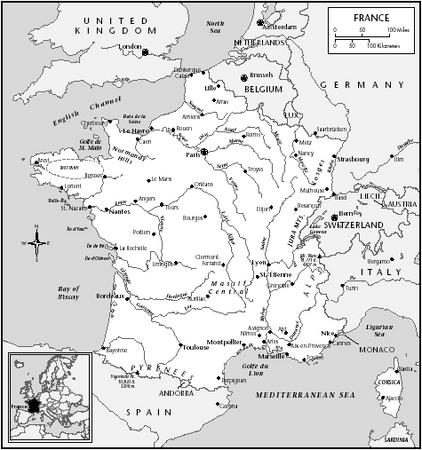
France
The nation historically has been divided into two linguistic regions: that of the langue d'oeil to the north and that of the langue d'oc to the south. National identity is closely identified with the French language. The purity of the language is officially protected by the Académie Française established by Cardinal Richelieu in the seventeenth century, whose forty members rule over the inclusion of new words in the language. In 1966, the government instituted a further safeguard by establishing a commission on the French language whose role is to discourage borrowings from English and franglais (the combination of the two languages). The Toubon law of 1994 mandates that French be spoken in all official, public spheres of life. The French state also has played a role in the protection of global francophonie. Then president François Mitterrand established the Haut Conseil de la Francophonie in 1984, which sponsors summit meetings among French-speaking countries.
Symbolism. Numerous national symbols are associated with the French Revolution, which established the nation as a democratic republic at the end of the eighteenth century. They were further reinforced during the Third Republic at the turn of the twentieth century. Known as the tricoleur, the flag is blue, white, and red. White is associated with monarchy, red with the republic, and blue with Charlemagne, Clovis, and other early rulers. La Marseillaise became the official national anthem in 1946. It was written in Strasbourg in 1792 but became associated with Marseille when troops from that city entered Paris singing it on 30 July 1792. It was an important rallying song during the First Republic but was not used on official occasions again until the Third Republic. The Gallic rooster ( le coq gaulois ) became associated with the nation during the Renaissance. It was used at first as a royal symbol but during the revolution came to stand for the identity of the nation. Used variously over time and sometimes associated with the figure of Liberty or Marianne, the rooster came to be known as a symbol of the nation during World War I. Today it is often used by sports teams.
Marianne is a symbol of the republic as a motherland and stands for the rallying cry of "liberty, equality, fraternity." Marianne became an official national symbol during the Third Republic, although this female figure developed out of female symbols dating back to the revolutionary period. There are multiple ways of depicting this figure. Statues and images have portrayed Marianne as wearing a helmet and at other times the Phrygian bonnet; during the Third Republic, she began to be seen wearing a crown of ripe wheat. Since the nineteenth century, mayors have commissioned a sculpture of Marianne for their town halls. Now these busts depict popular models, the first of whom was Brigitte Bardot. The most recent model, chosen in 1999 after much discussion and debate, is the actress Laetitia Casta.
History and Ethnic Relations
Emergence of the Nation. The emergence of the modern nation took place over several centuries and resulted from a combination of the cultural influences of Gauls, Romans, and Franks. France was inhabited mainly by the Gauls, a Celtic-language group, when the Roman conquest of the territory began in the first century B.C.E. : The Gallo-Roman period ended when the Frankish peoples began to enter the territory from the Germanic east during the fifth century, led by Clovis.The term "France" comes from the Franks and has had three historical meanings. It referred to the area around Paris; the Île-de-France region, which was originally a duchy; and the area known as the kingdom of France, ruled by Hugh Capet and his descendants. The Treaty of Verdun in 843 established the kingdom of "Western Francia" when land was divided between the heirs of Charlemagne's son, Louis the Pious. The medieval period was one of political fragmentation even as the state administrative bureaucracy grew. The Church supported the various monarchs, who claimed divine rule. After a long series of wars, France achieved political unity in the sixteenth century under Louis XIV. French became the official language, replacing Latin in official documents, in 1539. The revolution of 1789 established the First Republic and abolished the monarchy. Attempts to form the First and Second Empires by Napoleon and his nephew eventually were over-turned by the Third Republic (1870–1940). This period involved a heightened sense of national identity, with a return to the republican values of the revolution. It was also a period of heightened colonial expansion into Africa and Asia. During World War II, with the German occupation and the Vichy regime under Pétain, there was a crisis of national identity and a move toward rejection of the ideals of the revolution. A Fourth Republic was reconstituted after liberation at the end of the war, and this led to the current Fifth Republic, whose first president was Charles de Gaulle, elected in 1958.
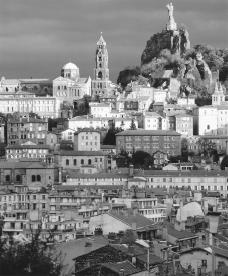
Le Puy lies in the volcanic mountains of south-central France.
National Identity. National identity is connected to notions of citizenship, which were established during the revolution. The original criteria included factors such as gender, place of birth, age, and amount of property. Citizenship currently depends on proof of parentage and residence. The national identity is based on several factors, including a concept of shared ancestry coming from the Gallic and Frankish past and territorial roots in the countryside, a shared national language and culture, and the ideals of the revolution. It has also been shaped by religious conflicts between Catholics, Protestants, and Jews and by religious versus secular influences on government, especially in the realm of education. Current national identity is primarily an invention of the Third Republic and has been shaken by various events in recent history. The degree to which a coherent national identity has existed is debatable despite the assimilationist policies of the government. Linguistic unity was achieved less than a century ago, and regional languages and cultural practices persist. The growth of the European Union (EU) and the influx of immigrants eventually will lead to a revised view of what it means to be French.
An important element of national identity is the identity card. Each person on French soil must carry on his or her person a card or document that demonstrates citizenship or another legal status, such as a visa or EU passport. The police have the right to stop anyone at any time to demand to see these documents.
Ethnic Relations. In a multiethnic state, there are two major types of ethnic group identity: that which is associated with territorial groups claiming a separate identity from the dominant French identity and that which is associated with immigrants, such as North Africans. Conflict between the centralized state and regional groups such as the Corsicans, Bretons, and Basques heightened toward the end of the twentieth century, when political autonomy became a major movement. Corsica has won the right to limited administrative autonomy.
About 4.5 million foreigners live in France. These immigrants have come from various nations. The country has offered political asylum to peoples such as Cambodians and Czechs. The largest immigrant groups are the Portuguese, Algerians, Moroccans, Spanish, Italians, and Tunisians. One of the most significant conflicts has been in the area of religious freedom for Islamic groups. The "scarf affair" of 1989, in which three Muslim girls were expelled from high school because they refused to take off their head scarves, drew attention to the conflict between the secular state school system and the religious beliefs of immigrants.
Urbanism, Architecture, and the Use of Space
There has long been a dichotomy between Paris and the rest of the nation or between Paris and the provinces. Paris is by far the major urban center, with Lyon following. Not until the 1960s did the urban population surpass the rural population. Four-fifths of the population now lives in urban areas. More than half the urban population lives in suburbs, however. A movement of population back to rural areas, if not back to farming, has existed since the 1970s. Only 3 percent of the population is employed in agriculture. Regions and cities are linked through an extensive rail system controlled by Societé Nationale des Chemins de Fer de France (SNCF). It is headquartered in Paris, with twenty-three regional areas. High-speed trains (TGV) link Paris with Lyons, Bordeaux, Calais, Strasbourg, and Montpellier/Marseille-Lyon. Paris is now linked through the English Channel tunnel to the United Kingdom. Several major highways built during the last few decades have improved movement by car.
Architecture ranges from the grand works of the powerful in the cities, such as the Versailles palace and the new National Library in Paris, to the vernacular architecture of rural areas. Buildings dating from the period of state building in the Third Republic are particularly symbolic of nationalism. The architecture of public primary schools built at the turn of the century in small towns and villages symbolizes the presence of the nation-state at the local level. These buildings also house the mayor's office. Churches symbolize the power of the Catholic Church, from Notre Dame in Paris to the village churches whose steeples once dominated the countryside. Vernacular rural architecture varies from region to region, reflecting climate, family forms, and cultural values. Just as each local region had a local dialect, it had its own style of barns and houses.
The use of space in rural areas varies considerably. There is a stark contrast between the south, where there is more open socializing outdoors and in cafés and a stricter gender division of spatial use, and the north, where there is less of an emphasis on these factors. In southern areas, where men tend to associate in cafés or in the town square, married women were traditionally not present in such public spheres but were confined to the household. Across the country, however, there is a strong emphasis on privacy within the walls of the house or foyer . Personal space and intimacy are connected, and close friends and relatives have much closeness and physical contact. Acquaintances and intimates are distinguished, and a high degree of formality is used with acquaintances.
Food and Economy
Food in Daily Life. Food plays a major role in the country's social life. Wine and cheese are sources of national pride and reflect regional differences. Meals are ritualized, and full of social and cultural meaning. There are also political aspects to the meaning of food. For instance, there has recently been much concern about the quality of "engineered" food and a rejection of foods that have been genetically altered. Another recent concern has been la vache folle (mad cow disease); the French have rejected the importation of English beef, which has been a major issue in the EU.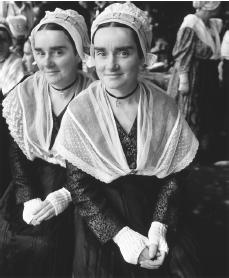
Breton girls in costumes for a festival. Each commune generally holds a festival during the year.
Meals involve a succession of courses eaten one at a time. A typical family meal starts with a soup, followed by vegetables and a meat dish and then a salad, cheese, and dessert. Wine is commonly served at meals. Children begin to drink wine during family dinners in their early teens, often drinking wine diluted with water. Most daily food preparation is done by wives and mothers in family settings even if both spouses work full-time. The need to prepare wholesome meals that reflect traditional values is an increasing source of stress for working women who feel pressed for time. Convenience foods are becoming more prevalent, and fast food is a growing trend.
Food Customs at Ceremonial Occasions. Large family gatherings and dinner parties involve more elaborate food preparation and more courses than daily family meals. At such occasions, drink is more important. An apéritif is served with small snacks or appetizers before the meal. Different regions have particular apéritifs : pastis is associated with southern France, and Suze (gentian liqueur) with the Auvergne. Wines complement the courses. Champagne often is served to mark ceremonial occasions and is drunk after the meal. This is followed by coffee and a digestif (liqueur). It is not uncommon for ceremonial meals to last three or more hours. In Normandy, a tradition that involves having a drink of calvados after each course further lengthens the meal.
Holidays are associated with special foods. Elaborate meals are served on Christmas Eve by Catholic families who attend midnight Mass. These meals involve salmon, oysters, turkey, and la bûche de noël cake. In many regions, crêpes are eaten on 2 February, the Feast of the Virgin. The ceremonial nature and symbolism of food are evident in rural wedding ceremonies. Often, mixtures of food and drink are presented to the wedding couple in a chamber pot in the early hours of the morning after the wedding. These mixtures can include champagne and chocolate or savory soups with carrots and onion.
In many rural regions, it is still common for families to slaughter a pig each winter and make sausages, patés, hams, roasts, and chops for freezing. These are ceremonial occasions, and each person who helps the family is given a portion of the pig.
Basic Economy. The "thirty glorious years" of expansion of industry after World War II ended with the oil crises of the 1970s. Since then, the country has rebuilt its economy and has one of the four leading economies in Western Europe. Most of the gross national product (GNP) comes from services, with industry generating one fourth of the GNP. France is also a major agricultural nation and is self-sufficient in this sector. Agriculture now accounts for less than 3 percent of the GNP, however. The major agricultural crop is wheat. High unemployment has plagued the country since the 1970s, particularly among youth. The unemployment rate was almost 13 percent in 1997. Inclusion in the EU has had a major impact on the economy, opening some markets and restricting others. In 2002, France will convert from the franc to the euro for all financial transactions. After several decades of nationalization of major industries, France deregulated those sectors in the 1990s, to create a freer market.
Land Tenure and Property. Until the middle of the twentieth century, agriculture was dominated by small holdings and family farms. Two factors have affected rural land holdings since World War II. There has been an acceleration of the rural exodus leading to a strong migration toward cities, along with a consolidation of farm lands that had been scattered through inheritance patterns. This was called le remembrement and was more successful in some regions than in others.
Commercial Activities. There are many small businesses and shops on city streets, and street markets thrive in the major cities. In the centers of towns, small shops and specialty boutiques abound. However, there are also large hypermarchés or grandes surfaces at the outskirts of most cities that sell food, clothing, and furniture. Prices are fixed in stores for the most part, but at markets there is still a lot of bargaining. The commercial services of rural villages have declined during the last twenty years, as a result of depopulation and the attraction of new chain stores. Increasingly, the butchers, bakers, and grocers have closed shop, and people make purchases in small shopping markets or travel to the nearest city to buy less expensive goods.
Major Industries. Industry historically was centered in the northeast and eastern part of the nation, primarily in Paris, Lille, and Lyon. This has changed with the penetration of industry into the hinterlands and the south. The leading industries are steel, machinery, chemicals, automobiles, metallurgy, aeronautics, electronics, mining, and textiles. Tourism is a growing industry in the countryside. Food processing and agribusiness are important to the national economy. The government controls several industrial sectors, including railroads, electricity, aircraft, and telecommunications. A move toward privatizing these industries has been under way since the early 1990s.
Trade. Although the country traditionally took a protectionist stance toward trade and did not play a major role in the world economy, this has changed with the opening of markets through the European Economic Community and the Common Market. Foreign trade grew during the 1950s, under de Gaulle, and by the mid-1960s, France was the fourth largest exporter in the world. Most exports
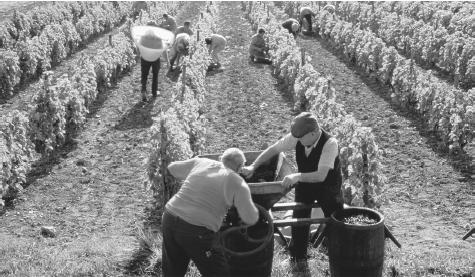
Men working at a vineyard in France. French wine is a source of national pride and an important part of both simple and elaborate meals.
Social Stratification
Classes and Castes. France is a class-stratified society whose middle class did not develop significantly until the 1960s. Historically, society was divided among the nobility, the bourgeoisie , the peasants, and the urban proletariat. The French system was the basis for much of Karl Marx's analysis of class struggles during the nineteenth century. The dominant class now is referred to as the bourgeoisie, although this term is difficult to define. Primarily, this class is considered to be the group that controls education and industry. A major source of debate is the issue of social mobility for people of different social origins. Statistics indicate that there is still a strong tendency for children to remain in the occupational class of their parents. For instance, in 1994, almost 50 percent of the children of workers became workers; only 9 percent of them became elite workers. Fifty-six percent of the children of elite workers became elite workers. The school system is blamed for the lack of social mobility.Symbols of Social Stratification. Social stratification has two main axes: urban versus rural and economic class position. The urban upper class generally has ties to provincial seats of power. The bourgeoisie establish the major tenets of good taste and refinement, of being "civilized." One's taste in music, art, food, and leisure activities generally reveals one's social class origins. Symbols of a higher class position include knowing not only about fine art but about the newest trends in avant-garde art, understanding and being able to purchase fine wines, and dressing with understatement while revealing refined aesthetic sensibilities. Class consciousness is very strong. "Symbolic capital" plays a large role in social class, and not only wealth but family connections and lifestyle determine one's social position and opportunities.
Political Life
Government. France operates under the constitution of the Fifth Republic, which was established in 1958. The government is highly centralized, although the 1982 act of decentralization transferred more power to the regions and communes. Paris is the capital city. The administration of the governmental system is organized through the levels of nation, region, department, arrondissement, canton, and commune. The commune is the smallest administrative level. This system of political administration dates back to the French Revolution. The state controls several state-owned companies in the areas of transportation, energy, and communications. Thirty percent of the workforce is employed by the state. The state bureaucracy is complex and is run by an administrative elite trained at the National School of Administration (ENA).The executive branch includes the president and the prime minister. The president is elected for a seven-year term by popular vote. The prime minister is appointed by the president and serves as head of the government. In recent years, a form of political "cohabitation" has developed, in which the president and prime minister come from different political parties. The prime minister selects the ministers and secretaries of state, with approval by the president. Legislative power resides in a bicameral parliament composed of the Assemblée Nationale (National Assembly) and the Senat (Senate). The deputies of the Assemblée Nationale are elected by popular vote for five-year terms; senators are elected though an electoral college system for nine-year terms.
The twenty-two metropolitan regions, which recently received a formal role in government, are each composed of several departments. A region is headed by a regional prefect and served by elected regional council members who represent the departments. The regional council elects a president of the council. The department is headed by a prefect, and each canton elects a council member to serve at that level. Communes elect a mayor and a municipal council. There are a little over 36,000 communes, and their populations can range in size from under one thousand to that of a large city. The vast majority of communes are in the countryside.
Leadership and Political Officials. France is politically divided between the right and the left. There are five major political parties. To the far right is the Front National (FN), which has been growing in power since the 1980s under the leadership of Jean-Marie Le Pen. The two major parties on the democratic right are the Rassemblement pour la République (RPR) founded by Jacques Chirac in 1976 and the Union pour la Democratie Française (UDF) founded by Valéry Giscard d'Estaing in 1978. On the left, there is the Parti Socialiste (PS) and the Parti Communiste Française (PCF). In 1981, the PS replaced the earlier SFIO, led by François Mitterrand. The Communist Party was formed in 1920.
Political leaders rise to power by gaining election at the local level, and then accruing more political titles. It is possible for a politician to hold more than one office at different levels simultaneously, and this is a common method for gaining political support. Election to office depends on social networks, as well as on the personal charisma of the politician. The concept of "legitimacy" is crucial; to be viewed as a legitimate candidate is to have local roots and a strong social network. A successful politician must make good use of symbolism and ritual in order to embody various ideals. A high degree of formality is associated with political office, and interactions with elected officials require correct etiquette. One should, for instance, address a mayor as Monsieur or Madame le Mayor.
Social Problems and Control. The police are a noticeable presence, particularly in urban areas and transport centers such as airports and subway stations. Visibly armed, they have the right to stop any person to demand to see documents of identity. The police force is divided between those who work for the minister of the interior and those who work for the minister of defense ( gendarmes ). There is also a National Security Police force (CRS) that is called in during demonstrations and strikes, which occur frequently. An important form of political protest, demonstrations often disrupt urban streets and highways. Labor unions are strong, and striking workers regularly stop social services, such as trash pickup and public transportation, and access to public buildings, such as museums.
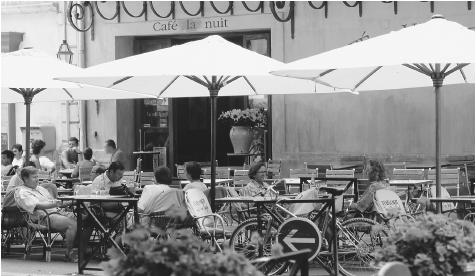
People at an outdoor café in France. Cafés are social centers for men in southern France and are also popular among tourists.
Military Activity. The president is the commander in chief of the military, and the minister of defense reports directly to the president. France has an army, navy, and air force. It also contributes to the United Nations military forces and is in the NATO alliance, although its relationship to NATO has been precarious at times. France was involved in several armed conflicts during the twentieth century. After the first and second world wars, it was involved in colonial wars in Algeria and Indochina. The draft is being phased out and will disappear in 2002. Universal compulsory military service for a period of at least sixteen months has been mandatory for all eighteen-year-old males and marked an important rite of passage into adulthood.
Social Welfare and Change Programs
There is an elaborate social welfare program. The social security system was formed in 1946. It is funded not by the state but by employers and workers directly. There are several plans, which vary with one's level of employment and professional status. A minimum level of income is assured for the unemployed and destitute under the RMI (Revenue Minimum d'Insertin), the unemployment assistance payment that is paid for through taxation. Benefits of the social security system include family allowances (paid per child), infant allowances for pregnant women and newborns, single-parent supplements, benefits for sickness and disability, and unemployment insurance.Nongovernmental Organizations and Other Associations
About half the people belong to a voluntary association, including political parties, and there are 800,000 associations. The 1901 Law of Associations regulates noneconomic activities such as sports clubs, cultural groups, and other clubs. There are clubs for immigrants, the elderly, youth, and leisure activities. Much of civic life is organized through associations.Gender Roles and Statuses
Division of Labor by Gender. Peasant households traditionally had a strict gender division of labor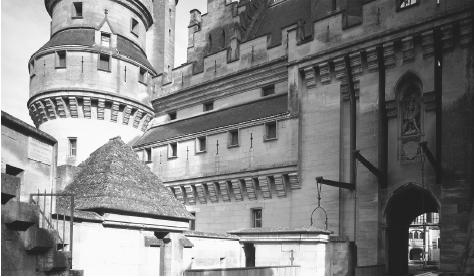
Architectural view of Pierrefont Castle, a reminder of the wars that have punctuated French history.
Marriage, Family, and Kinship
Marriage. Marriage rates and age at marriage are related to socioeconomic class and region. Overall, the marriage rate is declining and the age at marriage is rising. The average age of marriage for men is twenty-nine, and that for women is twenty-seven. Women tend to marry later when they seek higher education. Rural male celibacy has been associated with rural-urban migration since the 1960s. Geographic homogamy is a strong factor in marriage: Over half of all marriages involve partners from the same department. There is also a high level of religious homogamy. The divorce rate has increased in recent years, especially since a 1975 law that made the process easier and faster. One in three marriages ends in divorce. All marriages are sanctioned by a civil ceremony in the town hall. Religious ceremonies must follow the civil ceremony, so that frequently wedding parties make the trip between mayor's office and the church. Payment for the weddings of young people is most often divided equally between the families of the bride and the groom. There has been a rise in cohabitation for unmarried couples. A recent law permitting legal unions that are not marriages for couples has given legal status to cohabitating couples, including homosexual couples. The PACS ( pacte d'association civile et solidaire ) law, passed in 1999, set up an intermediate union between marriage and cohabitation. A pacte is easier to dissolve than a marriage.Domestic Unit. The basic domestic unit is called le ménage . This includes all persons living in the same dwelling. These persons are not necessarily related. There has been a rise in single-person households since the 1960s. In 1997, 18 percent of all households were composed of single women, and 12 percent of single men. Most households, however, are composed of couples with (35 percent) or without (28 percent) children. There were three types of domestic units traditionally: the patriarchal family, the stem family, and the nuclear family, which predominates today. In the patriarchal family (a rural model that was prevalent in parts of central France), siblings stayed at home and their spouses joined the household. These large families owned property jointly. In the more hierarchical stem family, which was the most common, there was a pattern of primogeniture. The eldest son would remain in the parental home, but daughters and younger sons were obliged to seek their fortunes elsewhere. That pattern persists in some rural communities, although primogeniture has been illegal since 1804 under the Napoleonic Code. One sibling takes over the farm but "pays off" the parts of the patrimony due to his or her siblings. The nuclear family was most prevalent in southern France and has a more egalitarian basis than the stem family. A young couple would be established in their own household by both sets of parents.
Inheritance. One of the major functions of the domestic unit is the transmission of property to children. Inheritance involves material and symbolic goods. Most property is held in the form of immovable goods such as buildings and land. Social inequalities are perpetuated through unequal access to inheritances among members of different families. Inheritance occurs not just at the death of the parents but at marriage or the setting up of a household for a young person, when loans or gifts are extended by parents. Inheritance also involves "cultural capital," including education, access to various lifestyles, and ways of speaking. Although the Napoleonic Civil Code established uniform regulation of inheritance and authority within the family and equal inheritance among siblings, there are regional variations in the application of the law.
Kin Groups. Kinship is bilateral, with kindreds being recognized as important units of social support. Kinship was historically more important for the peasantry and bourgeoisie than for workers or the petite bourgeoisie, who maintained neighborhood ties that were sometimes stronger than kin ties. Today the family plays a major role in transmitting cultural values, despite the decline in marriage and increasing geographic mobility. Most people continue to live in the region in which they grew up even if they move from a village to a city. Weekend visits to parents and grandparents are common. There is much diversity in the meaning and strength of kin ties across social class and ethnic lines. Ideologies of kinship, in which certain family forms are privileged over others, represent a critique of the kinship patterns of the working classes and immigrants.
Socialization
Infant Care. Infant care is done primarily by the mother, although fathers and female relatives participate. In the past, upper-class women sent their children to wet nurses until they were weaned. Children were swaddled with various methods, depending on the region. Baptism is an important familial celebration of the birth of an infant.Child Rearing and Education. State-sponsored schools for early childhood education begin to take children at the age of three. There are also state-subsidized child care centers for younger children. Although the influence of the family in childhood socialization is very important, there are regional and class-based variations in the methods used. In general, children have been seen as naturally "wild" and in need of learning how to behave in the proper ("civilized") way through guidance from adults. Peer socialization is as important as adult socialization, however, and children generally develop a strong peer culture. There are both public, state-run schools and private (mostly Catholic) schools, which receive some state aid if they follow the state curriculum. Public education was established as mandatory, free, and secular by the Ferry laws of the late nineteenth century. Education is controlled by the Ministry of Education and Research, with the exception of agricultural education, which is under the Ministry of Agriculture. There are three levels of public schooling: the primary school, the college, and the lycee. Schooling is mandatory until age sixteen.
Higher Education. Students receive a higher education after they have completed secondary schooling and successfully taken one of several examinations to earn a baccalaureat. Historically, higher education was divided between universities and grandes écoles. Decentralization efforts have been under way to counter the domination of Paris over academic research and teaching. Provincial centers of learning have grown and received increased funding. About 10 percent of all students are foreign. With the growth of the European Union, education initiatives have fostered partnerships between French universities and universities in other European nations.
Etiquette
In French, " etiquette " means both "etiquette" and "ceremony." Social class distinctions determine the importance of various forms of correct social behavior. In general when people greet each other, they shake hands or embrace with a kiss on both cheeks (called faire la bise ). Kissing is only done when two people are close friends or relatives. For the most part, the embrace is done only the first time in a day in which one sees someone and is not repeated again until one says good-bye. There is also formality in verbal greetings, so that one shows respect by adding "Madam," "Monsieur," or "Mademoiselle" to any greeting. There are important public and private distinctions. In public spaces, one generally does not smile at strangers or make eye contact with them (for instance, in the subway or bus) and should keep one's voice low when speaking. Privacy is also maintained in homes, so that doors to bedrooms and bathrooms are kept closed. When shopping in smaller stores, the buyer generally greets the proprietor upon entry, and the proprietor helps the client choose the goods to be purchased. It is less common to have free access in a store, although the growth of large hypermarkets and shopping malls is changing this custom.Religion
Religious Beliefs. France has been dominated by the influence of the Catholic Church, yet the constitution declares it to be a "secular" country. Secularism does not reject religion but attempts to bar any single religion from gaining political control. The minister of the interior is also the minister of religions, an office established to ensure the representation of various creeds. About 80 percent of the population is Roman Catholic. The second largest religion in terms of adherents is Islam. There are about a million Protestants; 700,000 Jews; and 200,000 Orthodox (Russian and Greek) Christians. There is also a significant Buddhist population. About 15 percent of the population claims the status of a nonbeliever. Religious practice has diminished during the last fifty years, and less than 10 percent of the population attends religious services.The dominance of Catholicism is historically linked to the conversion of Clovis in 496. In most of the country, communes began as parishes, and most rural villages see the local church building as a symbol of local identity. The church bell rings to mark deaths, wars, and weddings. French history is marked by religious struggles between Catholics and Protestants, especially during the wars of religion in the sixteenth century. Many Protestants fled during the seventeenth century, when their religious rights were rescinded by Louis XIV.
The French Revolution in the eighteenth century was in part a reaction to the power and wealth of the Catholic Church. The 1905 law passed during the Third Republic officially separated church and state. The split between republicans, who supported a secular state, and antirepublicans, who were conservative and Catholic, was strong at the local level in Catholic regions such as Brittany during the turn of the century. Anti-Semitism is symbolized by the Dreyfus Affair, which was sparked at end of the nineteenth century by the false conviction for spying and imprisonment under a death sentence of a Jewish army officer. This divided republican and antirepublican factions across the nation. Anti-Semitism was prevalent during the Vichy regime and has resurfaced with the neofascist Front National.
Folk religion varies by region. Witchcraft beliefs persist in some regions, such as the Vendée. Many Catholic regions combine elements of folk religion and Catholicism in their belief systems.
Religious Practitioners. Because of the strong influence of the Catholic Church, priests are the most important religious practitioners at the local level.
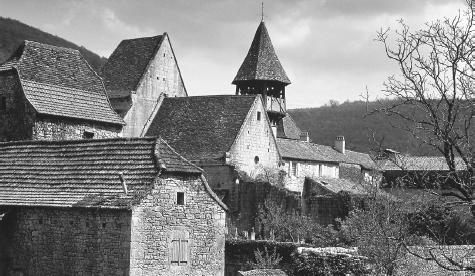
Characteristic stone buildings in the village of Lot. Privacy is strongly valued in French households.
Rituals and Holy Places. France was the site of many pilgrimages during the Middle Ages. Most regions have historic churches that are visited regularly on holy days, with processions leading to them. Lourdes is one of the best known pilgrimage sites in the world. Located in the Pyrenees region in the southwest, it is visited by five million people each year. In 1858, the Virgin Mary appeared to a young girl, Bernadette Soubirous, at the grotto in Lourdes. This miracle inspires handicapped and ill people to visit this site and take the waters, which are believed to have healing qualities. Lourdes has a Web site where one can hear the church bells and watch the visitors.
Death and the Afterlife. The Judeo-Christian tradition dominates beliefs about the afterlife, with heaven and hell playing a major role in the cosmology. In traditional rural areas, there was a fatalist approach to death, and in many regions, such as Brittany, a "cult" of death — especially among older women. Funerals are important events, drawing from the entire community. The cemetery in France is a symbolic site of memory, often visited by older female relatives who tend to family plots. Young children often accompany grandmothers for walks through cemeteries.
Medicine and Health Care
The French system of social security manages health care along with family allowances, retirement benefits, and unemployment. The national health system covers medical expenses and hospitalization for French citizens, and is run by a commission composed of representatives of employers and worker organizations. Most of the time, patients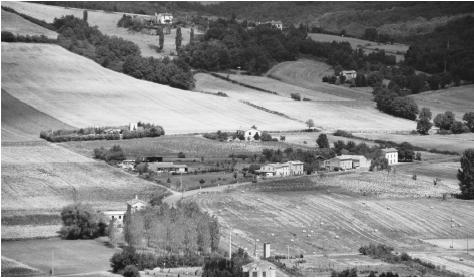
Only about 3 percent of France's population is employed in agriculture, although people have been moving back to rural areas to live since the 1970s.
The sale of birth control and legalization of abortion came much later in France than in other industrialized nations. The role of the Catholic Church in this is important, as is the influence of the women's movement on the changes in policy. Birth control was first permitted to be sold in 1967, and abortion did not become legal until 1975.
Secular Celebrations
France has several civic holidays ( jours feriés ), when schools, museums, and stores close. These public holidays, which include some with a religious origin, are: le Jour de l'An—1 January; May Day or Labor Day—1 May; World War II Victory Day—8 May; Easter (date varies); Ascension Day (after Easter); Pentecost Monday; Bastille Day—14 July; Assumption Day—15 August; All Saints Day or Toussaint—1 November; Armistice Day—11 November; and Christmas—25 December. Along with Bastille Day, Armistice Day is the most patriotic of these holidays, marking the end of World War I. There are speeches and parades in local communities involving local dignitaries and veterans, who place a wreath on the war memorial.Bastille Day is the most important national holiday, celebrated in every commune with town dances, fireworks, and other festivities. On this day, there is a parade down the Champs-Elysée in Paris, involving the President and other dignitaries. Bastille Day marks the storming of the state prison, known as Bastille, by the citizens of Paris during the French Revolution. Known popularly as the 14th of July ( le quatorze juillet ), Bastille Day celebrates the overthrow of monarchy and the beginnings of the French Republic.
Each commune in France generally holds a town festival during the year. In some regions, these incorporate religious and secular symbolisms. There are dances, parades, sports competitions, and other activities.
The Arts and Humanities
Support for the Arts. There is a great deal of support for the arts in France at the state, regional, and municipal levels. The French Ministry of Culture funds artists as well as restoration projects and museums.Literature. Oral traditions and folktales predominated in pre-modern France. Up until the mid-twentieth century, rural communities held veillées, in which neighbors gathered in someone's home around the hearth to trade stories and tales. French written literature is considered one of the greatest world traditions. The first works of literature in French were the Chansons de Geste of the eleventh century, a series of epic poems. During the Renaissance, France's great national literature flourished with works by François Rabelais, Michel Eyquem de Montaigne, and Pierre de Ronsard. Enlightenment writers such as Voltaire, Montesquieu (Charles-Louis de Secondat), and Jean-Jacques Rousseau helped to shape a national consciousness during this time. Nineteenth-century writers took up themes of struggles between social classes, clerical and anticlerical forces, and conservatives and liberals. They also developed a form of realist writing that charted the various regional differences, and urban-rural splits, in France. François-Auguste-René de Chateaubriand, Madame de Staël, George Sand, Victor Hugo, Stendhal (Marie-Henri Beyle), Honoréde Balzac, and Gustave Flaubert were the great novelists of this period. Poets included Charles-Pierre Baudelaire, Alphonse-Marie-Louis de Prat Lamartine, Arthur Rimbaud, Paul Verlaine, and Stéphane Mallarmé. Earlier twentieth century writers include Marcel Proust, Anatole France, Jules Romains, Sidonie-Gabrielle Colette, François Mauriac, Louis-Ferdinand Celine, and André-Georges Malraux. French existentialism during the postwar period is associated with writers Albert Camus and Simone de Beauvoir. The so-called "new novel" came to the fore in the 1950s and its representatives include Nathalie Sarraute and Alain Robbe-Grillet.
France gives several literary prizes each year. These include the Goncourt, the Renaudot, the Medicis, and the Femina.
Graphic Arts. France's most important graphic art forms are painting, sculpture, and architecture. The prehistory of French art is also important, including the famous cave paintings in southwestern France. The nineteenth century period of Romanticism in painting is associated with Eugène Delacroix and Jean-Auguste Ingres. Paintings of peasant life flourished during this century, particularly in the work of Jean Courbet and Jean-François Millet. Impressionism, in which color and light became important, is associated with Claude Monet, (Jean) Pierre Auguste Renoir, Camille Pissaro, Edgar Degas, Édouard Manet, and Morissette. Postimpressionism followed later in the century, with works by Henri Matisse, Paul Cézanne, Georges Seurat, and Pierre Bonnard. Great twentieth century painters include Georges Braque, and Jean Dubuffet. The most famous French sculptor is Auguste Rodin.
Performance Arts. Theater and dance have a strong tradition in France, both in the classical sense and in the realm of folklife. As in most of France's cultural life, Paris dominates the grand traditions of theater. France's great dramatists include Pierre Corneille, Jean Racine, Molière, Victor Hugo, Alexandre Dumas pere and fils, Jean Anouilh, and Jean Genet. The Comédie Française in Paris still presents the classic works of Molière and Racine. Opera is also popular in France, cutting across social class. Street theater, pageants, and regional theatrical productions flourish in the provinces. The city of Toulouse is particularly well-known for its performance arts. French cinema is subsidized more highly by the state than other European movie industries, and the French have access to more nationally-produced films than their neighbors. Many French cities hold movie festivals during the year, the most famous being that in Cannes in early summer.
The State of the Physical and Social Sciences
Most scientific research is supported and sponsored in France through the network of the CNRS (Center for National Research). Scientific research is also funded by the CNES (French National Space Agency) and INSERM (the National Institute for Health and Medical Research). France is among the four world leaders in scientific funding. The CNRS has funded many laboratories in which winners of Nobel prizes and Fields medal for mathematics have worked. CNRS (including the research institutes it funds) and French universities are the major sources of support for scientific research. Very often, professors and researchers at universities also have appointments at CNRS. There is, however, a series of exams that one must pass in order to enter into the CNRS.French ethnographic research in France is funded by the Mission du Patrimoine Ethnologique, which is part of the Ministry of Culture. The Mission participates in the journal Ethnologie Francaise and publishes its own journal, Terrain. It also publishes books in association with the Maison des Sciences de l'Homme, an institute for advanced research in Paris. Another major site for the anthropology of France is LAIOS, the Anthropological Laboratory for the Study of Institutions and Social Organizations in Paris.
Bibliography
Abélès, Marc. Quiet Days in Burgundy: A Study of Local Politics, 1991.Agulhon, Maurice. The French Republic, 1879-1992 . Translated by Antonia Nevill, 1993.
Badone, Ellen. The Appointed Hour: Death, Worldview and Social Change in Brittany, 1989.
Binet, Alain. Societé et Culture en France dupuis 1945, 2000.
Bourdieu, Pierre. Distinction: A Social Critique of the Judgement of Taste. Translated by Richard Nice, 1984.
Carroll, Raymonde. Cultural Misunderstandings: The French-American Experience. Translated by Carol Volk, 1988.
Corbett, James. Through French Windows: An Introduction to France in the Nineties. 1994.
De Planhol, Xavier, and Paul Claval. An Historical Geography of France. Translated by Janet Lloyd, 1994.
Levieux, Eleanor, and Michael Levieux. Insiders' French: Beyond the Dictionary. 1999.
Mendras, Henri, with Alistair Cole. Social Change in Modern France: Towards a Cultural Anthropology of the Fifth Republic, 1992.
Noiriel, Gerard. The French Melting Pot: Immigration, Citizenship, and National Identity. Translated by Geoffroy de Laforcade, 1996.
Nora, Pierre. Realms of Memory. Vol. I. Conflicts and Divisions. Translated by Arthur Goldhammer, 1983.
Pinchemal, Philippe. France: A Geographical, Social and Economic Survey, 1987.
Price, Roger. A Concise History of France, 1993.
Reed-Danahay, Deborah. Education and Identity in Rural France: The Politics of Schooling, 1996.
Rogers, Susan Carol. Shaping Modern Times in Rural France: The Transformation and Reproduction of an Averyronnais Community, 1991.
Segalen, Martine. Historical Anthropology of the Family . Translated by J. C. Whitehouse and Sarah Matthews, 1986.
Todd, Emmanuel. The Making of Modern France: Ideology, Politics and Culture, 1991.
Zeldin, Theodore. The French, 1982.


0 comments:
Post a Comment